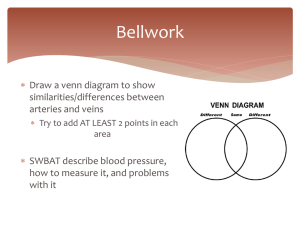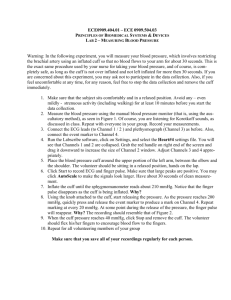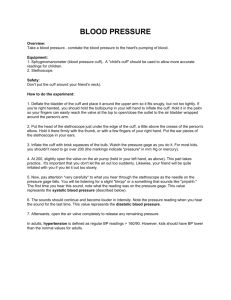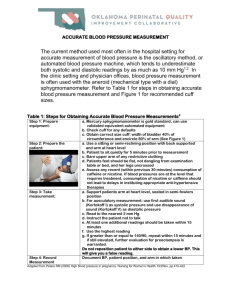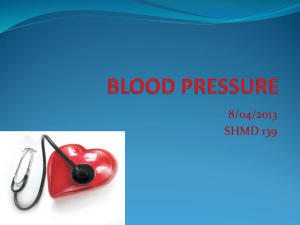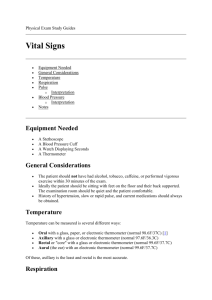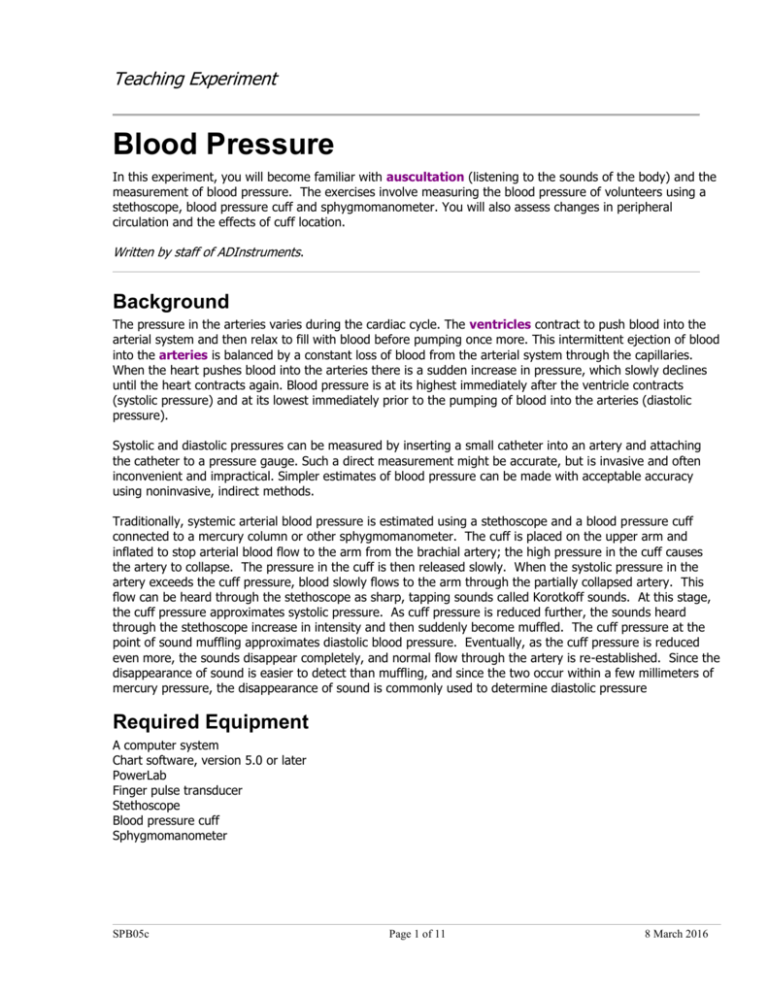
Teaching Experiment
Blood Pressure
In this experiment, you will become familiar with auscultation (listening to the sounds of the body) and the
measurement of blood pressure. The exercises involve measuring the blood pressure of volunteers using a
stethoscope, blood pressure cuff and sphygmomanometer. You will also assess changes in peripheral
circulation and the effects of cuff location.
Written by staff of ADInstruments.
Background
The pressure in the arteries varies during the cardiac cycle. The ventricles contract to push blood into the
arterial system and then relax to fill with blood before pumping once more. This intermittent ejection of blood
into the arteries is balanced by a constant loss of blood from the arterial system through the capillaries.
When the heart pushes blood into the arteries there is a sudden increase in pressure, which slowly declines
until the heart contracts again. Blood pressure is at its highest immediately after the ventricle contracts
(systolic pressure) and at its lowest immediately prior to the pumping of blood into the arteries (diastolic
pressure).
Systolic and diastolic pressures can be measured by inserting a small catheter into an artery and attaching
the catheter to a pressure gauge. Such a direct measurement might be accurate, but is invasive and often
inconvenient and impractical. Simpler estimates of blood pressure can be made with acceptable accuracy
using noninvasive, indirect methods.
Traditionally, systemic arterial blood pressure is estimated using a stethoscope and a blood pressure cuff
connected to a mercury column or other sphygmomanometer. The cuff is placed on the upper arm and
inflated to stop arterial blood flow to the arm from the brachial artery; the high pressure in the cuff causes
the artery to collapse. The pressure in the cuff is then released slowly. When the systolic pressure in the
artery exceeds the cuff pressure, blood slowly flows to the arm through the partially collapsed artery. This
flow can be heard through the stethoscope as sharp, tapping sounds called Korotkoff sounds. At this stage,
the cuff pressure approximates systolic pressure. As cuff pressure is reduced further, the sounds heard
through the stethoscope increase in intensity and then suddenly become muffled. The cuff pressure at the
point of sound muffling approximates diastolic blood pressure. Eventually, as the cuff pressure is reduced
even more, the sounds disappear completely, and normal flow through the artery is re-established. Since the
disappearance of sound is easier to detect than muffling, and since the two occur within a few millimeters of
mercury pressure, the disappearance of sound is commonly used to determine diastolic pressure
Required Equipment
A computer system
Chart software, version 5.0 or later
PowerLab
Finger pulse transducer
Stethoscope
Blood pressure cuff
Sphygmomanometer
SPB05c
Page 1 of 11
8 March 2016
Teaching Experiment
Procedures
Warning
As explained above, this procedure involves stopping blood flow to the arm. This is potentially
dangerous. Please take the following precautions:
Know what you are doing ahead of time.
Do not leave the cuff inflated for a prolonged time (more than 90 seconds or so).
The volunteer should flex and extend his or her fingers between the exercises to maintain blood flow.
If possible, use more than one volunteer during the course of the lab session.
A. Set up and calibration of equipment
Using a stethoscope
In order to perform this experiment correctly, you must be familiar with the use of the stethoscope (Figure
1). Most stethoscopes have an endpiece with a flat diaphragm and a concave bell, only one of which is
directly connected to the earpieces at any one time. The endpiece can be turned 180° to change the
working side. Typically, the connection bends away from the side of the endpiece that should be placed
against the skin. The bell is generally better than the diaphragm for this experiment because it reduces room
noise. The earpieces should point slightly forward to match the direction of the external auditory canal.
Make sure that the earpiece is properly positioned, and that the bell of the stethoscope is active. Tap on the
bell; if you do not hear sounds clearly, rotate the bell 180° on its endpiece.
Figure 1. The correct use of a stethoscope: note the angle of the connection to the endpiece; it shows
that the bell is currently selected.
Exercise 1: Auscultation of blood pressure
Objectives
In the first part of the experiment, you will measure the blood pressure of volunteers via auscultation.
Procedure
Only the stethoscope, blood pressure cuff and sphygmomanometer are needed for Exercise 1.
1. Place the blood pressure cuff around the upper portion of the arm of the volunteer (either arm), between
the elbow and the shoulder.
SPB05c
Page 2 of 11
8 March 2016
Teaching Experiment
2. Place the bell of the stethoscope over the brachial artery, as shown in Figure 2. The artery lies medial to
the biceps tendon, just above the elbow crease.
Figure 2. Proper placement of the blood pressure cuff.
3. Inflate the cuff until the pressure reaches approximately 180 mmHg.
4. Slowly reduce the pressure in the cuff (approximately 1 to 2 mmHg per second) while listening through
the stethoscope for Korotkoff sounds.
5. Note the pressure value at which sharp, tapping sounds are first heard. This is the systolic pressure
(Figure 3).
6. Continue slowly reducing cuff pressure (at 1 to 2 mmHg per second). The pressure value at the cessation
of sound is the diastolic pressure. Record the subject’s blood pressure in Table 1 of your Data Notebook.
7. Completely deflate the cuff once diastolic pressure is determined. Do not leave the cuff partially inflated
or leave it inflated for a long time.
8. Repeat the procedure using other volunteers until you feel confident in measuring blood pressure. Allow
the volunteers one to two minutes between procedures to recover.
SPB05c
Page 3 of 11
8 March 2016
Teaching Experiment
Figure 3. A graphical representation of the auscultation of blood pressure.
Exercise 2: Blood pressure and pulse
Objectives
In this part of the experiment, you will observe the changes in blood flow while measuring blood pressure,
and see if you can use pulse measurement to replace the stethoscope.
Procedure
You will require the PowerLab system and finger pulse transducer as well as the equipment you were using in
Exercise 1.
Make sure the PowerLab turned on and is connected to your computer.
1. Locate Chart on your computer and start the software. If the Experiments Gallery dialog box does not
appear in front of the Chart window, choose the Experiments Gallery… command from the File menu.
2. In the Experiments Gallery dialog box, select Blood Pressure from the left-hand list. Select the settings
file “BP Settings” from the right-hand list, and then click the Open button.
3. After a short time, the Chart window on the computer screen should appear set up for the experiment.
Channel 1 should be named “Blood Flow”.
Note: Channel 1 will show the raw signal from the finger pulse transducer, which indicates the net rate of
blood flow into the finger pulp.
SPB05c
Page 4 of 11
8 March 2016
Teaching Experiment
4. Connect the BNC plug on one end of the finger pulse transducer’s cable to the BNC socket for Input 1.
Rotate the connecting ring of the transducer plug clockwise until it locks. (See Figure 4 for the setup.)
5. Place the pressure pad of the finger pulse transducer against the distal segment (the tip) of the middle
finger of the volunteer’s hand (on the same arm as the blood pressure cuff). Use the Velcro strap to
attach it firmly — neither loose nor tight.
Figure 4. Connect the finger pulse transducer to
Input 1 on the PowerLab.
6. Ensure the volunteer is relaxed; have them put their hands in their lap and sit as still as possible to
minimize any signal from movement.
7. Choose the Input Amplifier… command from the Channel 1 (Blood Flow) Channel Function pop-up menu.
Adjust the value in the Range pop-up menu of the dialog box that appears so that the signal occupies
about a half to two thirds of full scale when the volunteer has both hands in their lap.
8. Click the OK button to return to the Chart window.
9. Click the Start button, and record the finger pulse for about ten seconds. During this period, enter a
comment called “Exercise 2”.
10. Inflate the cuff until the pressure is just above 180 mmHg. Note that the pulse signal disappears (Figure
5).
11. Slowly deflate the cuff at a rate of 1 to 2 mmHg per second. When the systolic pressure is first heard
through the stethoscope, press the Return key to enter a blank comment (this serves to mark the time).
Write down the pressure value from the sphygmomanometer.
SPB05c
Page 5 of 11
8 March 2016
Teaching Experiment
12. When the diastolic pressure is reached, press the Return key to enter a second blank comment, write
down the pressure value and then completely deflate the blood pressure cuff.
13. Click the Stop button to stop Chart recording. Use the View buttons in the Chart window to compress the
view horizontally to about 5:1 or so.
14. If you are saving your files, choose Save from the File menu to save the recording. Keep the file open for
the next exercises.
Figure 5. Typical results from Exercise 2, with comments
marking the times of systolic and diastolic pressures.
Exercise 3: Measuring systolic pressure
Objectives
In this part of the experiment, you will measure systolic blood pressure in the upper arm. Keep using the
Chart file already open.
Procedure
In this exercise, you can enter comments in advance, since you are entering blood pressure values you
know will appear. By default, Chart shows the comment text beside the dotted line marking a comment,
which makes reviewing such data quick and easy.
1. Click the Start button to start Chart recording. Type ‘Exercise 3, upper arm, 180’ to create a comment.
Do not press the return key.
2. Inflate the cuff to 180 mmHg and press the Return key to enter the initial comment for this exercise.
3. Slowly deflate the cuff at a rate of 1 to 2 mmHg per second. Type “170” to create a comment, and press
the Return key to enter it when the cuff pressure reads 170 mmHg.
SPB05c
Page 6 of 11
8 March 2016
Teaching Experiment
4. Continue adding comments for every 10 mmHg drop in pressure until 60 mmHg, typing “160”, “150”,
“140” and so on in advance, and pressing the Return key to add the comments when the pressure
reaches the value you have entered, as shown in Figure 6.
Figure 6. Chart recording showing the trace from the finger pulse transducer
during a blood pressure measurement.
5. Once the pressure has reached 60 mmHg, completely deflate the blood pressure cuff.
6. Click the Stop button.
7. If you are saving your files, choose Save from the File menu to save the recording.
SPB05c
Page 7 of 11
8 March 2016
Teaching Experiment
Exercise 4: Measurements from the forearm
Objectives
In this part of the lab, you will measure systolic blood pressure in the forearm, and compare your
measurements to those made from the upper arm. This exercise essentially repeats Exercise 3, with
measurements taken from a different site. Again, you can enter comments in advance, since you are entering
blood pressure values you know will appear.
Procedure
1. Move the cuff from the upper arm to the forearm, and adjust it as necessary to achieve a snug fit.
2. Click Start button to begin recording. Type “Exercise 4, forearm, 180” to create a comment. Do not
press Return.
3. Inflate the cuff to 180 mmHg and press the Return key to enter the initial comment for this exercise.
4. Slowly deflate the cuff at a rate of 1 to 2 mmHg per second. Type “170” to create a comment. When the
pressure reaches 170 mmHg, press the Return key to enter the comment.
5. Continue adding comments for every 10 mmHg drop in pressure until the cuff reaches a pressure of 60
mmHg, typing ‘160’, ‘150’, ‘140’ and so on in advance, and pressing the Return key to add the comments
when the pressure reaches the value you have entered.
6. Once the pressure has reached 60 mmHg, then completely deflate the blood pressure cuff.
7. Click Stop.
8. If you are saving your files, choose Save from the File menu to save the recording.
Exercise 5: Measurements from the leg
Objectives
In this part of the experiment, you will attempt to measure systolic blood pressure in the leg and compare
your measurements to those made from the arm. This exercise is a variation of Exercises 3 and 4, with
measurements taken from a different site, with the volunteer both sitting and standing. Again, you can enter
comments in advance, since you are entering blood pressure values you know will appear.
Procedure
1. Have the volunteer sit and remove his or her left shoe and sock.
2. Place the finger pulse transducer on the distal segment of the left big toe of the volunteer and wrap the
Velcro to attach the unit firmly to the end of the toe.
3. Note: The volunteer must not stand on or put weight on the finger pulse transducer, as this may damage
it and give incorrect pulse signals.
4. Wrap the cuff around the calf of the volunteer’s left leg.
5. Click Start. Type “Exercise 5, leg, sitting, 180” to create a comment. Do not press Return.
6. Inflate the cuff to 180 mmHg and press the Return key to enter the initial comment for this exercise.
SPB05c
Page 8 of 11
8 March 2016
Teaching Experiment
7. Repeat the procedures from the previous exercise, slowly deflating the cuff and adding comments to
mark the pressure. Once the pressure has reached 60 mmHg, then completely deflate the blood
pressure cuff. Click the Stop button to stop Chart recording. If you are saving your files, choose “Save”
from the File menu to save the recording.
8. Have the volunteer stand, once they have recovered.
9. Click Start.
10. Type “Exercise 5, leg, standing, 180” to create a comment. Do not press return.
11. Inflate the cuff to 180 mmHg and press the Return key to enter the initial comment for this part of the
exercise.
12. Repeat steps 10 and 11 while slowly deflating the cuff and adding comments to mark the pressure.
Once the pressure has reached 60 mmHg, then completely deflate the blood pressure cuff.
13. Click Stop.
14. If you are saving your files, choose Save from the File menu to save the recording.
Analysis
Exercise 1: Auscultation of blood pressure
Record the systolic and diastolic pressures you measured in Table 1.
Exercise 3: Measuring systolic pressure
Examine your data trace in the Chart window.
Enter the value for your estimate of systolic pressure in Table 2 of your Data Notebook.
Compare this value with the systolic pressure you recorded in Table 1.
Exercise 4: Measurements from the forearm
Examine your data in the Chart main window.
Estimate the systolic pressure from your trace and record your result in Table 2 of your Data Notebook.
Exercise 5: Measurements from the leg
Examine your data in the Chart main window.
Estimate the systolic pressure from your trace and record your result in Table 2 of your Data Notebook.
SPB05c
Page 9 of 11
8 March 2016
Teaching Experiment
Data Notebook
Table 1. Estimates of blood pressure using auscultation.
Subject’s Name:
Systolic Pressure (mmHg)
Diastolic Pressure (mmHg)
Trial 1
Trial 2
Trial 3
Trial 4
Average of all four trials
Table 2. Systolic blood pressure measured at different places on the body.
Measurement location
Systolic pressure (mmHg)
Upper arm
Forearm
Leg
Study Questions
Exercise 1
1. What are some possible sources of error or variation in this technique of blood pressure measurement?
Exercise 2
2. Does the time of the first Korotkoff sound (systolic pressure heard through the stethoscope), as indicated
by the first blank comment in your recording, correspond with the first appearance of blood flow?
SPB05c
Page 10 of 11
8 March 2016
Teaching Experiment
3. Since you are looking for the first appearance of blood flow, would slowing the rate of pressure release
from the cuff make your readings more accurate? What problems might be caused by slowing pressure
release?
4. Does the time that diastolic pressure is heard through the stethoscope, as indicated by the second blank
comment in your recording, correspond with anything particular in the blood flow signal? Can you,
therefore, use pulse measurement to replace the stethoscope?
Exercise 3
5. Is your estimate similar to the measured values obtained in Exercises 1 and 2?
Exercise 4
6. Is there any significant difference in the blood pressure obtained from the upper arm and the forearm?
Exercise 5
7. Are the values obtained for the leg the same as those obtained for the arm? Explain any differences.
8. What happened to the pressure value when the volunteer was standing? Explain your answer.
Copyright © 2004 ADInstruments. All rights reserved.
MacLab and PowerLab are registered trademarks, and Chart and Scope are trademarks, of ADInstruments. Windows and the
Windows logo are either trademarks or registered trademarks of Microsoft Corporation. Macintosh and the Mac logo are either
trademarks or registered trademarks of Apple Computer, Inc. Other trademarks are the properties of their respective owners.
www.ADInstruments.com
SPB05c
Page 11 of 11
8 March 2016


